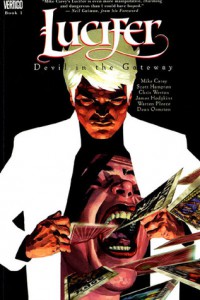
It takes some arrogance, worthy of the Prince of Lies himself, to claim, as this book does, that the book is based on characters created by Neil Gaiman, Sam Kieth, and Mike Dringenberg. I would think that, at the very least, John Milton might have some prior claim on the creation of Lucifer, the fallen angel, but in the legal shenanigans of the comic world, what that claim is actually revealing is that this graphic novel is a spin-off from Gaiman’s incredibly popular Sandman series. As such, it shares a lot in common with Gaiman’s re-envisioning of mythology. In Sandman: Seasons of Mist, Lucifer resigned from his post in Hell, had his wings cut off by Dream, and “retired” to host a nightclub called Lux in a distorted reflection of Rick’s from Casablanca, although in Lux, Lucifer plays his own piano. This book and series picks up where that left off, opening with a visit from an angel of the host to Lucifer to offer him a job for whatever price Lucifer will name. Thus begins the wheels-within-wheels that is the hallmark of this series.
In his introduction, Gaiman states that whenever another comic writer would ask him what he thought should spin-off from Sandman, he always told them “Lucifer,” which is likely not what any of them wanted to hear, instead hoping for dream assignments (pun intentional) like Death, Desire, or Destiny. But, as in most things relating to his comic, Gaiman was spot on. He had already covered the possibilities with the Endless, while Lucifer was the perfect protagonist: extremely flawed yet ultimately intriguing, charming and deadly, full of pride but also hubris. Lucifer is the character you don’t want to like, but you can’t help yourself from doing so because, unlike the throne of Heaven, Lucifer is much more like us. The Bible may say that man was created in God’s image, but our personalities were grafted from Lucifer.
This collection has three main story arcs: “The Morningstar Option,” where Lucifer fulfills a job for Heaven, and shows that he’s a right bastard to any who doubted; “A Six Card Spread,” in which Lucifer attempts to discover if his payment from Heaven has any strings attached that he wasn’t aware of; and “Born with the DEAD,” which seems ancilliary to the ongoing story, as it’s about a young girl who tries to figure out how and why her best friend died with Lucifer showing up near the denounement to provide a favor which will put the girl in debt to him. There’s a thread of story that weaves through these three, but, as in Gaiman’s Sandman, it will take at least another three or four collections before you start to see the resulting weave that begins here.
Each arc has a different team of artists. I appreciated Scott Hampton’s work on “The Morningstar Option” the most, because his art is both exact and yet abstract, almost dreamlike in its openness. The art by Weston and Hodgkins for “A Six Card Spread” is too realistic for a horror/fantasy comic, which works in this case by making some of the uglier parts of the story even uglier. “Born with the DEAD’s” Pleece and Ormston ply a middle ground between realistic representation and a Marc Hempel-style abstraction. Their’s is the kind of art that I don’t like for its own sake, but works extremely well with the story.
[Finished 7 January 2006]
